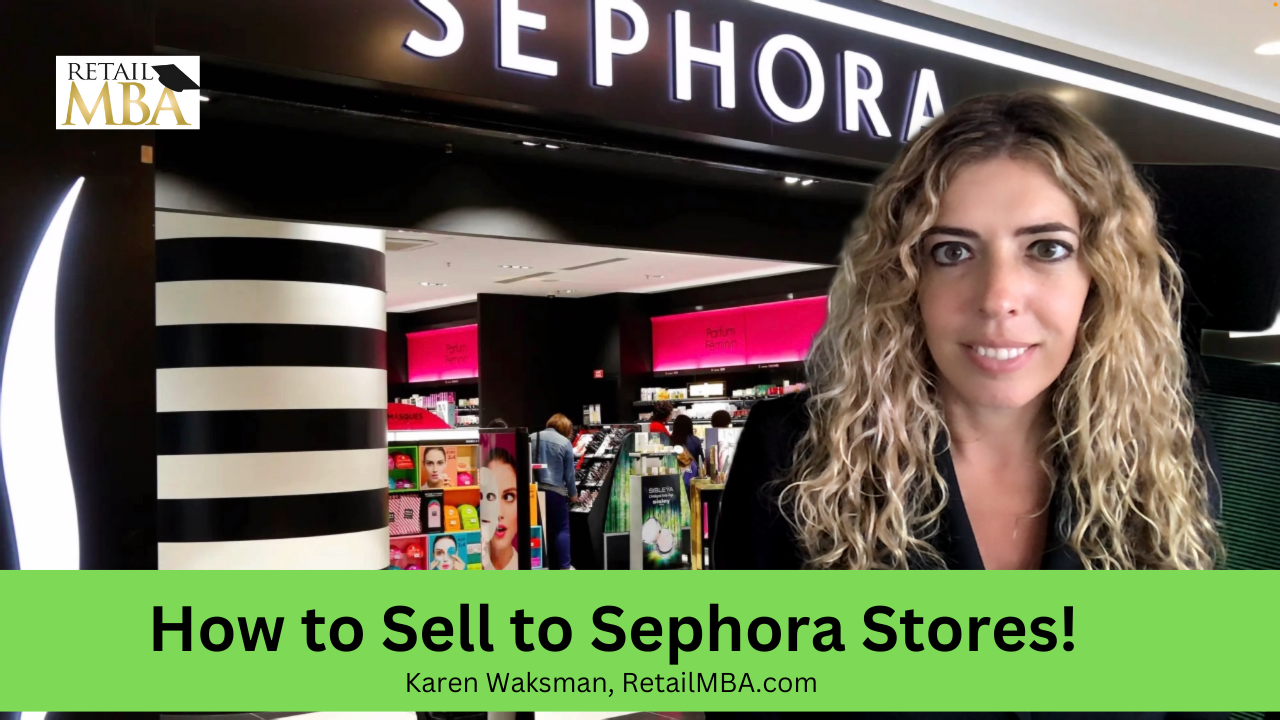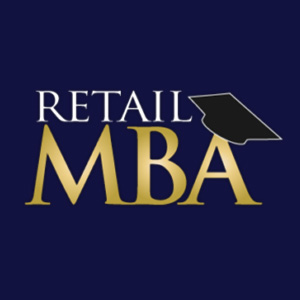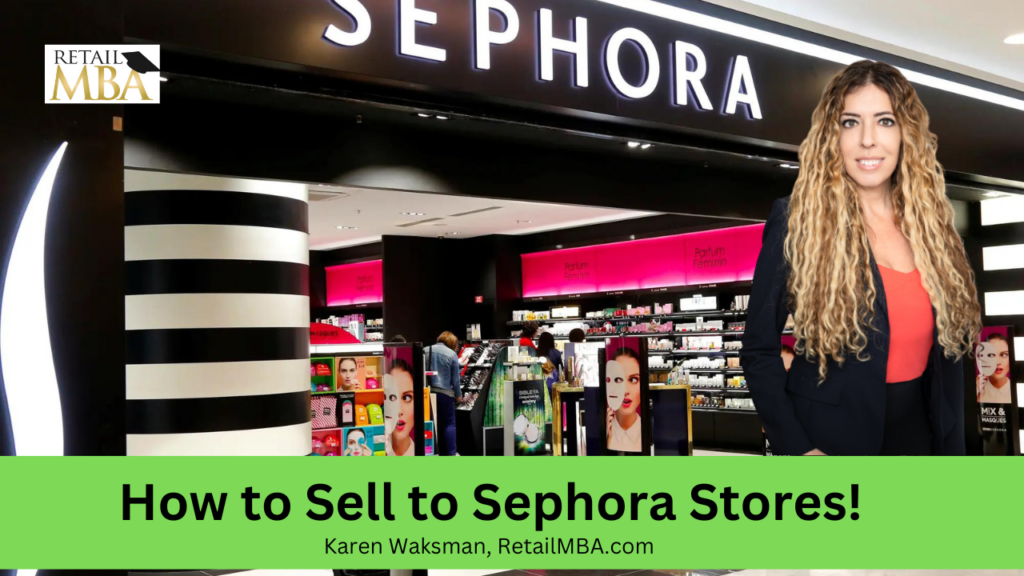Are you interested in becoming a vendor for Sephora? If you have a consumer product that you believe would be a fit for Sephora stores, Karen Waksman, the founder of Retail MBA, can provide you with some helpful tips and strategies to get started!
Karen has personally achieved success as a manufacturers representative by selling millions of consumer products to the retailers worldwide. Over the 12 years she has also imparted her knowledge to 100,000 individuals on the art of selling to retailers.
Sephora -The Ultimate Destination for Cosmetics Brands
For cosmetics brands Sephora is considered the destination. Whether its hair or cosmetic products Sephora is often regarded as the dream retailer. It’s quite common for people to hold a regard for this retailer.
However, one should be aware that selling to Sephora can be challenging due to their selection of brands and vast range of products. If you ever visit their stores you’ll notice an array of products, from brands.
If your product is unique and doesn’t belong to a collection or line it may prove difficult to sell to them. Alternatively one approach could be labeling your product and offering it through Sephora. Have you ever noticed that they display generic brand products in sections without any specific branding? These are commonly referred to as label products.
If Sephora purchases products from companies like yours. Then requests you to package your product under their brand name. This option usually applies to brushes and various other items.
If your goal is to sell your brand to Sephora meaning your brand name appears on the packaging it’s important to keep in mind that they will likely expect a range of products from you. On the hand if you’re looking to create a label product for them it is often feasible. Just remember that it may not carry your branding or packaging.
Tips for Selling to Sephora
Sephora is extremely knowledgeable about all cosmetics and related products in the market. It can be quite challenging to sell through this retailer not because they won’t accept your product but because they have encountered an array of offerings.
When a retailer has established itself in a niche and achieved success they may reject numerous submissions on a daily basis.
Recommendation from Karen
Karen suggests that if you decide to pursue selling, through Sephora go for it! However if they decline your proposal please don’t take it personally.It’s just that targeting a retailer, like this can be challenging because all your competitors are also vying to sell to them.
However Karen suggests that when dealing with a niche retailer like this it’s better to approach retailers who sell products, such as cosmetics in your case and try selling to them first. Once you have evidence of sales then you can approach a retailer like Sephora. They are more likely to agree because you can demonstrate proof of sales and customer purchases.
Sephora is primarily focused on profitability. However having a niche retailer already onboard does make it harder for them to say yes to new vendors since they receive numerous inquiries from everyone.
This doesn’t mean they aren’t open to testing products or considering partnerships; it just means that if they reject your proposal don’t take it personally.
Karen also suggests targeting retailers like Ulta, Macys, department stores or discount department stores. All of these places sell cosmetics or similar items like what you’re offering. By reaching out to them and building proof of sales there you can circle back. Approach Sephora, with more credibility.Here’s a approach instead of going through the disappointment of rejection feeling down about yourself and not making any progress, with that particular retailer because you believe they don’t like you.
Some Quick Tips and Strategies
Retail buyers often switch jobs frequently every six months to a year. They change positions so the buyer who was responsible for purchasing your product may not be there anymore when you approach them again.
So even if they reject you initially don’t worry much. There’s still a chance for you to sell to them.
Sephora values diversity. If your business is women owned or minority owned it would be beneficial to get certified as such. This could potentially expedite your entry into their doors. They are always on the lookout for brands that cater to markets and they highly appreciate certifications.
If you’re interested in learning how to reach out to Sephora. What words to use, how to pitch your products even if you have no sales experience. Please refer to the links provided below.
Retail MBA specializes in helping individuals get their products stocked in chain stores, like Sephora.
If you enjoyed this information please show your support by liking, subscribing and joining their community. They consistently produce content that you’ll love.
Starting the process of selling to Sephora
Selling your products through Sephora may seem challenging. Its definitely achievable. Karen Waksman offers tips and strategies that can assist you in getting started.
Begin by targeting retailers who specialize in cosmetics or similar products and try to secure sales with them. Once you have evidence of sales approach a retailer, like Sephora. They are more likely to consider purchasing from you when they see proof of sales and customer satisfaction.
Sephora values diversity so if your business is women owned or minority owned consider getting certified. This certification can potentially expedite the process of entering their market.
If you’re interested in learning how to approach Sephora what words to use when pitching them or how to persuade them to purchase your products – even if you have no sales experience – please check out the links provided below.
Retail MBA specializes in helping individuals like yourself get their products onto the shelves of chain stores, like Sephora.
Sephora Vendor - How to Sell to Sephora - Transcript Outline!
Sephora stores are highly coveted, by cosmetic brands making it quite challenging to become a vendor for them due to their range of known brands and products. Karen Waksman, the founder of Retail MBA shares tips and strategies for those looking to sell their products at Sephora.
Karen, who has a track record of selling millions of consumer products to retailers as a manufacturers representative has been teaching people about selling to retailers for over 12 years. In this article she offers insights into strategies that can help you successfully pitch your product to Sephora.
Brand Presence
One hurdle when it comes to selling at Sephora is the presence of brands offering a wide variety of products. As Karen points out if you have a product that doesn’t fit neatly into their existing lineup it can be challenging to get your foot in the door. However one option worth considering is labeling your product for Sephora. Karen explains that Sephora often works with companies like yours by incorporating your product into their packaging alongside brushes and other cosmetics.
If you aspire to sell your brand through Sephora keep in mind that they are interested in a selection of products, than just one item.If you’re considering labeling your product it’s important to keep in mind that it may not align with your brand when it comes to packaging.
Selling to Sephora
Selling to Sephora can be challenging due, to their knowledge of cosmetics and other products. They have a discerning eye for what they choose to stock on their shelves. When a retailer establishes themselves in a niche and achieves success they can afford to turn down offers.
Karen suggests that if you’re determined to pursue Sephora go for it. If they reject your product don’t take it personally. Karen advises exploring retailers, in the cosmetics industry or whatever market you’re targeting. By gaining sales proof from these avenues you’ll have evidence of your products potential when approaching Sephora again.
Sephora prioritizes profitability. This also means they face a volume of competitors vying for their attention and trying to make sales pitches.
However Karen makes a point that Sephora’s open, to testing and considering new products.
If you happen to face rejection from Sephora don’t fret. Buyers frequently switch jobs in the industry within a span of six months to a year. This means that the person in charge of purchasing your product may not be there when you approach them again. So there’s still an opportunity for you to make a sale.
Diversity Certifications
Karen also highlights the significance of diversity. Sephora values diversity. Being a supplier can give you an advantage. If your business is women owned minority owned or holds certifications it could expedite your entry into their market. Sephora constantly seeks out brands that cater to the consumer base and they appreciate certifications.
To sum up becoming a vendor for Sephora may not be easy. It is definitely achievable. Prioritizing labeling your product and exploring retailers before approaching Sephora can increase your chances of success. Additionally being a supplier can help expedite your entry into their market. At Retail MBA they specialize in assisting individuals with getting their products onto shelves at chain stores, like Sephora.
Frequently Asked Questions on Selling to Sephora Stores!
- How do I get my products into Sephora stores?
To get your products into Sephora stores, you will need to apply to become a Sephora vendor. You can do this by visiting Sephora’s website and completing an online vendor application. Or you can follow our Retail MBA (https://www.retailmba.com) Training System where we explain how the sales professionals actually sell into these types of retailers!
If you went the traditional route, the application process typically involves submitting a product sample and accompanying product information sheet (PIS), which should include details on your product, pricing and availability information, and any other relevant information when they ask!
Once you have submitted your application, a Sephora buyer will review your submission and determine if your products are a good fit for the company. If your application is approved, you will be invited to become a Sephora vendor and will be given access to the company’s systems and processes. Unfortunately, if you actually submit your product on their website, they don’t always respond. Or review your product appropriately as they ask you very generic questions about your brand and you don’t always get your products reviewed correctly. We try to rectify this through our Retail MBA Training System as we have time-tested proven methods to getting into these types of chain stores! No experience required!
To increase your chances of success, it is important to thoroughly research the market and identify a product that meets a specific need or demand. It is also important to demonstrate that you are able to produce high-quality products that offer value to customers and that you have a reliable supply chain.
Overall, getting your products into Sephora stores requires a strong commitment to quality and customer service, as well as the ability to meet the company’s strict vendor requirements. With hard work and dedication, it is possible to build a successful partnership with Sephora and grow your business. Plus you can make millions of dollars with one chain store order. We are here to help as a Retail consultancy if you need help with this!
- How do I contact Sephora buyers?
There are a few ways you can contact Sephora buyers:
- Use the “Contact Us” form on Sephora’s website: You can visit Sephora’s website and use the “Contact Us” form to send a message to the appropriate department. This is a good option if you are not sure which department or buyer to contact. This is also presented in the vendor section of their website. We highly recommend ignoring this route as buyers tend to overlook amazing products on their website through their vendor portal. Which is why the Founder of Retail MBA is the one who created our powerful Retail MBA Training System which unlocks how to approach, pitch and find the Sephoraers for you to sell to. You can take a look at what we are up to at https://www.retailmba.com.
- Do NOT Reach out through LinkedIn: Many Sephora buyers have LinkedIn profiles, which you can use to connect with them directly. You can search for buyers by name or job title and send them a message through LinkedIn but do not reach out to them this way. Many people suggest this. Buyers despise it when you reach out to them in disrespectful ways. Linkedin is where they post their resumes. Not reviewing products!
- Attend industry trade shows and networking events: Sephora buyers often attend industry trade shows and other events, where you can meet them in person and pitch your product. There are trade shows for every product category. For instance, housewares products can attend the International Housewares Show! Our Founder, Karen Waksman, has spoken at most of the top trade shows on how to sell to retail chains. These are great shows! Please check out our training on how to utilize trade shows appropriately. We explain what NOT to do when going to trade shows in our Retail MBA Training and Coaching Systems.
- Contact the buyer directly: If you know the name and contact information for a specific Sephora buyer, you can try reaching out to them directly. You can do this by emailing or calling them, but never through sending them a direct message on LinkedIn. If you go this route, do not annoy buyers. Find out what words to use when contacting buyers to get them to actually review your products! Our systems all teach how to do this in a way that buyers love! We’ve taught well over 100,000 product companies how to pitch buyers with our systems listed on RetailMBA.com.
It is important to be respectful and professional when contacting Sephora buyers, and to make sure you have a clear and compelling pitch for your product. It is also a good idea to do your research and tailor your pitch to the specific interests and needs of the buyer you are contacting.
- What are Sephora’s vendor requirements?
Sephora has a number of vendor requirements that must be met in order to do business with the company. These requirements can vary depending on the type of products you are selling and the market in which you operate. Some of the key requirements include:
- High-quality products: Sephora is committed to offering its customers high-quality products at affordable prices. As a vendor, you will need to demonstrate that you are able to produce products that meet the company’s standards for quality.
- Safety and compliance: Sephora has strict requirements for the safety and compliance of the products it sells. This includes requirements for materials, labeling, packaging, and other aspects of product design.
- Reliable supply chain: Sephora relies on a global network of suppliers to meet the needs of its customers. As a vendor, you will need to demonstrate that you have a reliable supply chain that is able to meet the company’s demand for products. Handmade goods would not make sense to sell to Sephora buyers – they buy in volume!
- Competitive pricing: Sephora is known for offering its customers epic prices, and as a vendor, you will need to be able to offer competitive pricing in order to do business with the company.
- Strong customer service: Sephora values strong customer service and expects its vendors to provide timely and accurate responses to customer inquiries and complaints.
- There is a list of requirements they require listed on their vendor portal. Check out their vendor website and you will find out insurance requirements and more!
Overall, becoming a Sephora vendor requires a strong commitment to quality and customer service, as well as the ability to meet the company’s strict vendor requirements. With hard work and dedication, it is possible to build a successful partnership with Sephora and grow your business.
- How do I prepare a Sephora product submission?
To prepare a Sephora product submission, you will need to create a product sample and accompanying product information sheet. The product sample should be a physical representation of your product, while the product sell sheet should include detailed information on your product, including its features, benefits, and Sephora market. Do not randomly send samples to them. Buyers need to request these samples! Otherwise you will usually never get a review process from buyers.
Here are some steps you can follow to prepare a Sephora product submission:
- Research the market: Before you start preparing your product submission, it is important to research the market to ensure that your product meets a specific need or demand. You should also research Sephora’s product offerings and make sure your product is a good fit for the company.
- Create a product sample: Your product sample should be a physical representation of your product that demonstrates its features and benefits. You should consider creating prototypes or samples in multiple sizes, colors, or variations to give Sephora buyers a better understanding of your product.
- Create a product information sheet (PIS): Your PIS should include detailed information on your product, including its features, benefits, Sephora market, pricing, and availability. You should also include any relevant images or graphics that will help buyers to understand your product. We explain EXACTLY how to create the best sell sheets for buyers in our powerful Retail MBA Training System listed on RetailMBA.com.
- Review and edit your submission: Once you have created your product sample and sell sheet, it is important to review and edit your submission to ensure that it is accurate and complete. You should also double-check that you have included all relevant information and that your submission meets Sephora’s guidelines.
- We teach you exactly what words to use and how to get buyers to buy in a fraction of the time and cost. Be sure to check out our free webinars listed on RetailMBA.com. We explain all of this in detail!
Overall, preparing a Sephora product submission requires careful planning and attention to detail. By following these steps and ensuring that your submission is accurate and complete, you can increase your chances of success and get your products on Sephora’s shelves. These are just a few random examples of how to prepare a product submission. Our core Retail MBA Training System takes 10 hours to explain what actually will happen to you if you sell to a retail chain. Why? One chain store order can mean 10’s of millions of dollars to your bottom line. The more you know, the better you will succeed.
- What are Sephora’s private label requirements?
To prepare a Sephora product submission, you will need to create a product sample and accompanying product information sheet. The product sample should be a physical representation of your product, while the sell sheet should include detailed information on your product, including its features, benefits, and Sephora market. Again, our Core Retail MBA Training System explains how to create a powerful sell sheet and how to contact the private label buyer and submit your product as would the sales professionals!
Here are some first steps you can follow to prepare a Sephora product submission:
- Research the market: Before you start preparing your product submission, it is important to research the market to ensure that your product meets a specific need or demand. You should also research Sephora’s product offerings and make sure your product is a good fit for the company.
- Create a product sample: Your product sample should be a physical representation of your product that demonstrates its features and benefits. You should consider creating prototypes or samples in multiple sizes, colors, or variations to give Sephora buyers a better understanding of your product.
- Create a product information sheet: Your sell sheet should include detailed information on your product, including its features, benefits, Sephora market, pricing, and availability. You should also include any relevant images or graphics that will help buyers to understand your product.
- Review and edit your submission: Once you have created your product sample and sell sheet, it is important to review and edit your submission to ensure that it is accurate and complete. You should also double-check that you have included all relevant information and that your submission meets Sephora’s guidelines.
- 6. Branding and packaging: Sephora’s private label products must be clearly branded and properly packaged to ensure that they stand out on the shelf and are easy for customers to identify.
Overall, preparing a Sephora product submission requires careful planning and attention to detail. Why? One order can make you millions of dollars!
When working with the private label buyer, they will instruct you on how to package using their branding! All of this is explained in our training systems listed on RetailMBA.com
- How does Sephora source products?
Sephora sources products from a wide range of vendors, both domestic and international. The company has a team of buyers and sourcing professionals who are responsible for identifying and evaluating potential vendors and products.
To source products, Sephora uses a variety of methods, including:
- Online vendor application: Sephora has an online vendor application process that allows potential vendors to submit product samples and information sheets for review. This is a good option for small and medium-sized businesses that are interested in selling their products in Sephora stores.We suggest not going through this route as you could get lost in the process. Find out more by checking out one of our Retail MBA Training systems listed on RetailMBA.com.
- Trade shows and industry events: Sephora buyers often attend trade shows and other industry events to discover new products and meet with potential vendors.
- Direct contact: Sephora buyers may also reach out to potential vendors directly, either through online channels or by attending industry events and networking with other professionals.
- Partnering with manufacturers: Sephora may also work directly with manufacturers to develop private label products or to secure exclusive distribution rights for certain products.
Overall, Sephora uses a variety of methods to source products, including online applications, trade shows, direct contact, and partnerships with manufacturers. The company is always looking for high-quality products that offer value to customers and that meet the company’s strict vendor requirements.
- What is Sephora’s return policy for vendors?
Sephora’s return policy for vendors varies depending on the product and the circumstances of the return. In general, the company has a “no return” policy for many types of products, but may make exceptions in cases where there are quality issues or other problems with the product.
If a customer returns a product to Sephora that was manufactured or supplied by a vendor, the vendor may be responsible for accepting the return and providing a refund or replacement product. In these cases, the vendor should work with Sephora to resolve the issue and ensure that the customer is satisfied.
If a vendor is unable to accept a return or provide a refund or replacement product, Sephora may choose to dispose of the product or return it to the vendor at the vendor’s expense.
Overall, it is important for vendors to have a clear understanding of Sephora’s return policy and to work closely with the company to resolve any issues that may arise. By providing high-quality products and excellent customer service, vendors can minimize the risk of returns and build strong, long-lasting partnerships with Sephora.
We explain how to avoid chargebacks and fees with Sephora! All listed on our training and coaching systems listed on RetailMBA.com.
- How do I become a Sephora preferred vendor?
To become a Sephora preferred vendor, you will need to meet the company’s vendor requirements and demonstrate that you are able to produce high-quality products that offer value to customers. You will also need to have a reliable supply chain and be able to offer competitive pricing.
To apply to become a Sephora vendor, you can visit the company’s website and complete an online vendor application. The application process typically involves submitting a product sample and accompanying product information sheet, which should include details on your product, pricing and availability information, and any other relevant information. Or follow our amazing systems that explain what to do!
Once you have submitted your application, a Sephora buyer will review your submission and determine if your products are a good fit for the company. If your application is approved, you will be invited to become a Sephora vendor and will be given access to the company’s systems and processes.
To become a preferred vendor, you will need to consistently meet the company’s expectations and demonstrate a track record of producing high-quality products. This may involve meeting certain performance metrics, such as on-time delivery, order accuracy, and customer satisfaction.
Overall, becoming a Sephora preferred vendor requires a strong commitment to quality and customer service, as well as the ability to meet the company’s strict vendor requirements. With hard work and dedication, it is possible to build a successful partnership with Sephora and grow your business.
Step-by-step training on how to sell to retail chains!
We explain exactly how to do that and how to get started today. I’ve taught over 100,000 of companies over the years across the globe on how to get your products to the stores. And so we’re here to support you. Or please subscribe to our Youtube channel and or be on the lookout for additional training that we create.
We are here to expedite the process of generating revenue with your physical products and that’s what we’re all about. Take a look at our advanced training, live events, certification programs and so much more.
In this training, I will discuss some of the things to think about when approaching a retailer to sell your products and become a vendor. Hope it helps! 🙂
Karen Waksman,
Retail MBA
Questions? Contact Us!
1-855-Retail-2 (Call or Text)
Email: info@retailmba.com
Retail MBA provides a step-by-step formula on How to Sell to Major Retailers, Online Retailers, Smaller Retailers, Catalogs and More. No Experience Required! These solutions continue to convert for clients year-over-year! These are Time-Tested and Proven Strategies that we utilize ourselves when going after stores! Everything we teach, we test. Want access to these formulas? ANY one of our programs and coaching systems gives you access to them now. With that said…
Here are 5 Easy Ways to Work with Us:
1) Free Training – If You Would Like to Join Our Next FREE Webinar Training Called “Retail Chain Store Secrets – How to Sell to Major Retail Chains. No Experience Required” Then Sign Up NOW To Learn All About Selling into Retail Chains By Clicking Here!
2) Retail MBA Year Long Coaching and Training System – Our Year Long Coaching and Training System with Karen Waksman is POWERFUL! This is our most popular training and coaching system! We walk you through how to approach, pitch and sell to retail chains and we coach you along the way! Join us by Clicking Here!
3) Masterclass Intensives – Want to Join our Next 4 Week Elite Retail MBA Masterclass Intensive? These Intensives Are EPIC for people who Love Fast Paced Learning – Homework, Retail Coaching, Developing Your Strategy, Buyers Contacts and More! These Events Are Held Every Quarter. Join us by Clicking Here!
4) Done-for-You Program – If You Want Karen Waksman and Her Team to Reach Out to Your Top Dream Retail Chains On Your Behalf – And You Have a Retail-Ready Product, Check Out our Epic Done-For-You Service by Clicking Here!
5) In Person Events – If You Want to Learn LIVE and Meet Karen Waksman in Person at Our Next “America’s Next Retail Product: LIVE Event with Other Like-Minded Individuals in Beautiful San Diego, CA! We Would LOVE to Have You Join Us by Clicking Here!
Check Out Our Additional Blog Posts Here:
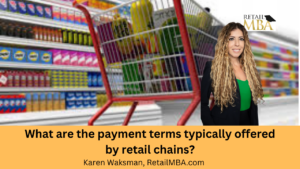
Retail Terms
Retail Terms – What are the payment terms typically offered by retail chains? Click Here to Learn More!
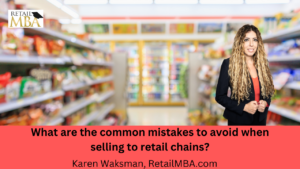
Retail Vendor
Retail Vendor – What are the common mistakes to avoid when selling to retail chains? Click Here to Learn More!
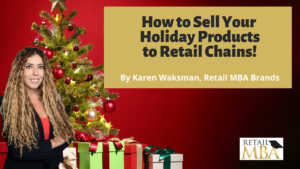
How to Sell Your Holiday Products to Retail Chains
New Training on How to Sell Your Holiday Products to Retail Chains
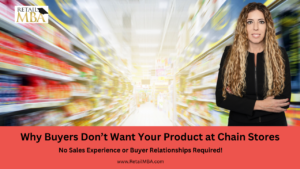
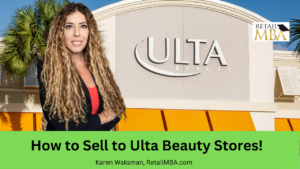
Ulta Beauty Vendor
Ulta Beauty Vendor – How to Sell to Ulta Beauty Stores. Click Here to Learn More!
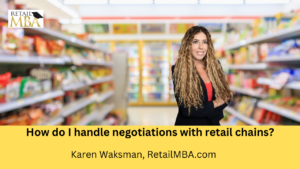
Retail Strategy
Retail Strategy – How do I handle negotiations with retail chains? Click Here to Learn More!
